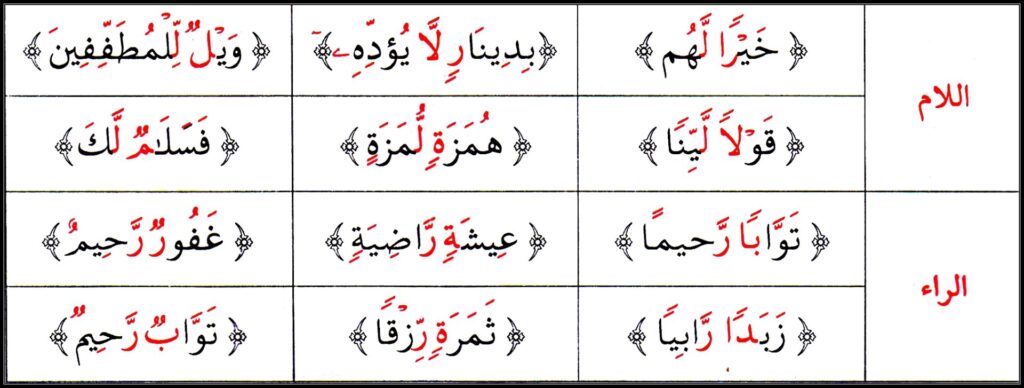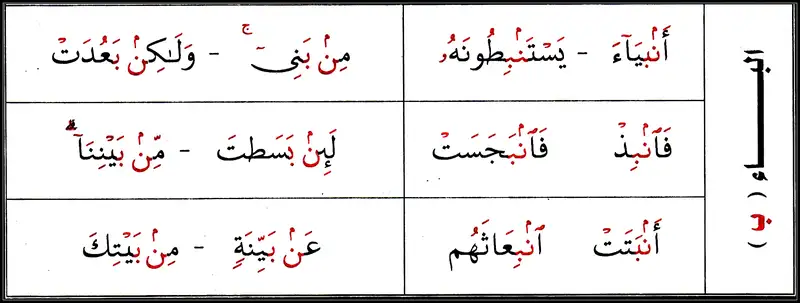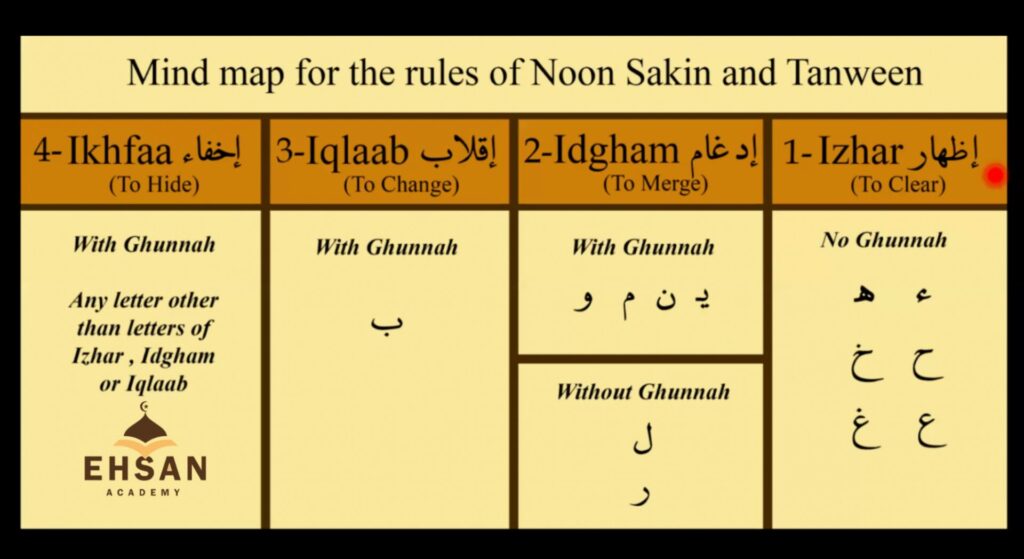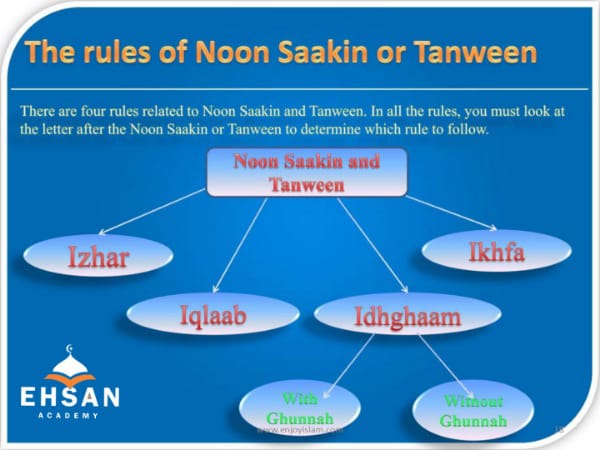Noon sakinah rules and tanween rules are one of the most important rules in tajweed so here we are going to answer some questions about them besides explaining each rule of them in detail.
The diacritical mark that is added to the letter “noon” (ن) to signify that it is a consonant and should be spoken without a vowel sound is known as Sukoon.
Table of Contents
- 1 Noon Sakinah and Tanween Rules are four rules:
- 2 Conclusion
- 3 FAQS.
- 3.1 What is tanween in Quran?
- 3.2 Idgham noon saakin examples :
- 3.3 Tanween in Arabic examples:
- 3.4 5 examples of izhar in the Quran :
- 3.5 Izhar noon saakin
- 3.6 Arabic words with tanween
- 3.7 Tanween words
- 3.8 How many tanween rules are there?
- 3.9 What does noon sakinah mean?
- 3.10 How many Izhar letters are there?
- 3.11 How many ikhfa letters?
Noon Sakinah and Tanween Rules are four rules:
1- Idham. 2- Izhaar. 3- Iqlab. 4- Ikhfa .
1- Idgham
Idgham is merging the noon sakinah or tanween sound with the following letter and it is one of the Tajweed rules that is used when a letter with a noon saakin (a diacritical mark that indicates the absence of a vowel sound) or tanween is followed by one of the letters “Ba,” “Meem,” “Waaw,” “Ya,” or “Nun.” ( ي – ر- م – ل – و- ن ) In such cases, the noon saakin is merged with the following letter, and the two letters are pronounced as one sound.
There are two types of Idgham: Idgham with ghunnah and Idgham without ghunnah.
- Idgham without ghunnah: This type of Idgham is used when the word after the noon saakin starts with a letter other than “ra or lam ( ر – ل ).” In this case, the noon saakin is merged with the following letter, and the two letters are pronounced as one sound without any nasal sound (ghunnah).
For example, in the word “abdan radeya” the letter “Ra ” follows the noon saakin. The noon and the “Ra” are merged, and the word is pronounced as “abadar radeya” with a nasal sound.
Examples with idgham without ghunnah

- Idgham with ghunnah: This type of Idgham is used when the word after the noon saakin starts with one of the letters “Meem,” “Waaw,” “Ya,” or “Nun.” ( ي – م – و- ن ) In this case, the noon saakin is merged with the following letter, and the two letters are pronounced as one sound with a nasal sound (ghunnah).
For example, in the word “yawmaedhen yasduru” the letter “ya ” follows the noon saakin. The noon and the “ya” are merged, and the word is pronounced as “yawmaedhey yasduru” with a nasal sound.
In this instance, the sound of Noon Saakinah and tanween is combined with the letter that follows or in another simple way the noon sakinah or tanween sound wull be silent and the letter after will be doubled rather than being pronounced independently.
examples of idgham with ghunna

Idgham noon saakinah and tanween examples :
يَوْمَئِذٍ يَصْدُرُ (Al Zalzalah 6 )
رَسُولٌۭ مِّنَ ٱللَّهِ يَتْلُوا۟ صُحُفًۭا مُّطَهَّرَةًۭ ( Al Bayyebah 2 )
إِنَّ ٱلَّذِينَ كَفَرُوا۟( Al Bayyenah 5 )
فِيهَآ أَبَدًۭا ۖ رَّضِىَ ( Al Bayyenah 7 )
إِنَّ إِلَىٰ رَبِّكَ ٱلرُّجْعَىٰٓ ( Al Alaq 8 )
The application of Idgham requires a precise understanding of the merging of sounds and the application of the rule in different contexts. It is important to note that the application of Idgham must not alter the meaning of the word or change its pronunciation beyond recognition
In conclusion, Idgham is a Tajweed rule that is used when a letter with a noon is followed by one of the letters (ي – ر – م – ل – و – ن )The noon is merged with the following letter, and the two letters are pronounced as one sound with or without a nasal sound. The application of Idgham requires a precise understanding of the merging of sounds and the application of the rule in different contexts.
2- Izhar
In Tajweed,
Izhar means to pronounce the sound of the Noon Sakinah or Tanween clearly without adding or hiding it.
the throat letters (حروف الحلق) are a group of Arabic letters that are pronounced from the throat. These letters are also known as the letters of Izhar, and they require a lot of effort and energy to pronounce properly.
Izhar letters or throat letters in Arabic are six letters
- ء (Hamzah)
- هـ (Haa)
- ع (Ain)
- ح (Ha)
- غ (Ghain)
- خ (Kha)
- The throat letters are pronounced deep in the throat, and they require the mouth to be opened wide to produce the sound properly. The proper pronunciation of the arabic throat letters is important in Tajweed, as it can significantly affect the meaning of words.
- The throat letters are also important in Tajweed because they interact with other Tajweed rules, such as the rules of Madd, Idgham, and Qalqalah. The proper application of these rules requires a precise understanding of the pronunciation of the throat letters and the diacritical marks that are used to indicate their pronunciation.
- Izhaar meaning Quran plays an important role in pronunciation. If Noon Saakinah appears before an Izhar letter, it should be pronounced clearly (openness).
Izhar letters in Arabic are pronounced from the throat that’s why they are called throat letters
The pronunciation of Noon Saakinah and Tanween in this instance is will be normal and clear which means they will be pronounced without adding or removing anything.
Izhar in Quran: Surah Al-Fatihah contains one instance of “Izhar” in the text. In verse 4, the word “Iyyaka” (إِيَّاكَ) is spoken with “Izhar” as a distinct and clear “ya” sound rather than merging it with the sound that comes after it, “ka.” It is crucial to pronounce this word correctly with the sound “Izhar” since it sets it apart from other words with a similar sound and communicates the verse’s intended meaning.
examples of izhar in Quran

مِنْ أَحَدٍۢ (ankabut 28)
بِعَذَابٍ أَلِيمٍ ( luqman 7 )
بِٱلْمُؤْمِنِينَ مِنْ أَنفُسِهِمْ ( Ahzab 6 )
In conclusion, the throat letters in Tajweed are a group of Arabic letters that are pronounced from the throat. They are essential in Tajweed because they affect the meaning of words and interact with other Tajweed rules. The proper pronunciation of the throat letters requires a lot of effort and energy, and it is important to understand the diacritical marks that are used to indicate their pronunciation.
3- Iqlab
iqlab means that if a Noon Saakinah or tanween appears before the letter Ba (ب) with a Fathah (ـَ) on it, the sound changes to Meem (م). An example of iqlab letter is the word “men ba’d” which is pronounced “mem ba’d,”, what happens when the Noon Saakinah sounds change to a Meem sound in this situation?
or in another way
In Tajweed, Iqlab is a rule of recitation that involves the pronunciation of the Arabic letter “noon” (ن) when it is followed by the Arabic letter “ba” (ب). The Iqlab rule requires that the sound of the letter “noon” is changed to a nasal sound that is similar to the sound of the letter “meem.”
The proper pronunciation of the Iqlab rule is important in Tajweed as it can significantly affect the meaning of words in the Quran. The Iqlab rule is also related to other Tajweed rules, such as the rules of Madd and Idgham, and the proper application of these rules requires a precise understanding of the pronunciation of the Arabic letters and the diacritical marks that are used to indicate their pronunciation.
– Iqlab letters are one letter and it’S ba (ب)
– Iqlab examples from Quran
عَلَىٰ مَا فَرَّطتُ فِى جَنۢبِ ٱللَّهِ( Al Zumar verse 56)
كَلَّا ۖ لَيُنۢبَذَنَّ فِى ٱلْحُطَمَةِ (Al Humazah verse 4)

In conclusion, Iqlab is a rule of recitation in Tajweed that involves the pronunciation of the Arabic letter “noon” when they are followed by the letter “ba” with a shaddah. The Iqlab rule requires that the sound of the letter “noon” is changed to a nasal sound similar to the sound of the letter “meem.” The proper application of the Iqlab rule is important in Tajweed to ensure the correct pronunciation of words in the Quran and to avoid any confusion or alteration of their meaning.
4- Ikhfa
In Tajweed, Ikhfa is a rule of recitation that involves the pronunciation of certain Arabic letters in a specific way. Ikhfa means “to conceal,” and the rule requires that the sound of the Arabic letter is pronounced in a way that is slightly concealed or muted.
Ikhfa letters are 15 letters and here they are : (ت – ث – ج – د – ذ – ز – س – ش – ص – ض – ط – ظ – ف – ك – ق)
When any of these letters appear after noon and the noon has nothin above it. the sound of the noon sakinah or tanween should be pronounced in a way that is slightly muted or concealed. The sound is not completely hidden, but it is not pronounced as strongly as it would be without the sakinah.
The Ikhfa rule is represented by having nothing written above the letter that requires Ikhfa. when the noon has nothing it indicates that the sound of the letter should be slightly muted or concealed.
The proper application of the Ikhfa rule is important in Tajweed as it can significantly affect the meaning of words in the Quran. The Ikhfa rule is also related to other Tajweed rules, such as the rules of Madd and Idgham, and the proper application of these rules requires a precise understanding of the pronunciation of the Arabic letters and the diacritical marks that are used to indicate their pronunciation.
If Noon Saakinah or Tanween appears before one of the letters of Ikhfa, the sound is concealed or muffled (ghunnah). The Tajweed of Ikhfa and Ikhfa letters are 15 letters (ت – ث – ج – د – ذ – ز – س – ش – ص – ض – ط – ظ – ف – ك – ق)
In this instance, Noon Saakinah is uttered in a very low voice that resembles a whisper.
ikhfa examples from Quran


If you are still wondering what is Tanween in Quran and wants to learn Tajweed effectively, drop us a message today!
The minute details of Tajweed should not be ignored in our recitation. Hence, if you want to learn more about it, join our Online Quran recitation course with Tajweed. Learn Quran online free in the free trial classes and get to know all about the course!
In conclusion, Ikhfa is a rule of recitation in Tajweed that involves the pronunciation of certain Arabic letters in a slightly muted or concealed way when they appear with a sakinah or a noon sakinah. The proper application of the Ikhfa rule is important in Tajweed to ensure the correct pronunciation of words in the Quran and to avoid any confusion or alteration of their meaning.
Conclusion
The Tajweed rules of the Quran are very important for the recitation of the Quran. Tajweed is the science of proper pronunciation and recitation of the Quran, and it involves a set of rules and guidelines that help reciters to recite the Quran correctly and beautifully.
The importance of Tajweed rules of the Quran can be summarized as follows:
- Preserving the Quranic text: Tajweed rules help to preserve the original text of the Quran by ensuring that it is recited correctly and accurately. The Quran is the word of Allah as revealed to the Prophet Muhammad (peace be upon him), and it is of great importance to Muslims. By reciting the Quran with proper Tajweed, Muslims can ensure that the text is preserved in its original form and that its meaning is conveyed accurately.
- Enhancing understanding: Tajweed rules help to enhance the understanding of the Quranic text by ensuring that it is recited in a clear and understandable manner. The proper application of Tajweed rules can help reciters to convey the correct meaning of the Quranic text, which can deepen their understanding and appreciation of the Quran.
- Beautifying the recitation: Tajweed rules help to beautify the recitation of the Quran by giving it a melodious and rhythmic quality. The proper application of Tajweed rules can make the recitation of the Quran more appealing and enjoyable to listen to, which can help to attract people to the Quran and Islam.
- Spiritual benefits: Tajweed rules are believed to have spiritual benefits for the reciter and the listener. The proper recitation of the Quran with Tajweed is considered a form of worship and can bring blessings and rewards from Allah. The melodious recitation of the Quran can also have a calming effect on the listener and can help to soothe the mind and heart.
when we recite the Quran and want to connect with it, we must put extra effort on Tajweed and its application. So, learn Tajweed rules today and join our online Quran recitation with tajweed course.
In conclusion, the Tajweed rules of the Quran are of great importance to Muslims, as they help to preserve the text, enhance understanding, beautify the recitation, and bring spiritual benefits. The proper application of Tajweed rules requires knowledge, practice, and dedication, but it is a rewarding experience that can deepen one’s connection to the Quran and Allah.
How does the Ikhfa rule relate to the rules of Madd and Idgham?
The Ikhfa rule in Tajweed is related to the rules of Madd and Idgham because it affects the pronunciation of certain letters in words, and its proper application can impact the application of these other rules.
Madd is a rule in Tajweed that involves the elongation of certain vowel sounds. When applying Madd, the duration of the vowel sound is extended for two, four, or six vowel counts, depending on the type of Madd being applied.
Idgham is another rule in Tajweed that involves the merging of certain letters. When applying Idgham, the sound of a letter with a sakinah is merged with the sound of the letter that follows it. The Ikhfa rule also applies when the letters (ت – ث – ج – د – ذ – ز – س – ش – ص – ض – ط – ظ – ف – ك – ق) appear after a noon and both idgham and ikhfa are noon sakinah and tanween rules.
In both Madd and Idgham, the application of the Ikhfa rule affects the pronunciation of the letters involved. When the Ikhfa rule is applied, the sound of the letter with the sakinah is pronounced in a way that is slightly muted or concealed, which can affect the duration or merging of the sound with the following letter.
The proper application of the Ikhfa rule is important in Tajweed, as it can significantly affect the meaning and sound of words in the Quran. The accurate application of the rules of Madd and Idgham also requires an understanding of the Ikhfa rule and its impact on the pronunciation of letters with a sakinah or noon sakinah.
now the four rules of noon sakinah and tanween have been done.
FAQS.
What is tanween in Quran?
Tanween in Quran is when there is a double Dammah on the top of a letter( لٌ) or double Fatha on the top of letter ( لً) or double Kasrah below the letter (لٍ). Each one is called Tanween and all are called Tanween too, they have four rules: 1- Idgham. 2- Izhaar. 3- Iqlab. 4- Ikhfa.
Idgham noon saakin examples :
أَحَسِبَ ٱلنَّاسُ أَن يُتْرَكُوٓا۟ أَن يَقُولُوٓا۟ ( Al ankabut 2)
لِتُنذِرَ قَوْمًۭا مَّآ (Yaseen 6)
إِنَّ ٱلَّذِينَ كَفَرُوا۟( Al Bayyenah 5 )
إِنَّ إِلَىٰ رَبِّكَ ٱلرُّجْعَىٰٓ ( Al Alaq 8 )
Tanween in Arabic examples:
يَوْمَئِذٍ يَصْدُرُ (Al Zalzalah 6 )
رَسُولٌۭ مِّنَ ٱللَّهِ يَتْلُوا۟ صُحُفًۭا مُّطَهَّرَةًۭ ( Al Bayyebah 2 )
فِيهَآ أَبَدًۭا ۖ رَّضىَ ( Al Bayyenah 7 )
5 examples of izhar in the Quran :
صراط الذين أنْعَمت عليهم (Surah Fatiha: verse 4)
فَأَمَّا مَنْ أَعْطَىٰ وَٱتَّقَىٰ ( Al Lail 5 )
وَأَمَّا ٱلسَّآئِلَ فَلَا تَنْهَرْ ( Al Duha 10 )
عَبْدًا إِذَا صَلَّىٰٓ ( Al Alaq 10 )
مَنْ هُوَ أَشَدُّ مِنْهُمْ قُوَّةً ِ (Surah Al-Baqara verse 23)
Izhar noon saakin
If there is Noon Saakinah or Tanween comes before an Izhar letter, it should be pronounced clearly, so in fact you do nothing with noon sajin or Tanween except pronounce them normally with their sound.
Arabic words with tanween
نوحاً – علمٍ – قومٌ
Tanween words
لوطاً – شعيباً – نذيرٌ – أحدٍ
How many tanween rules are there?
There are four rules for tanween :
1- Idgham: merging or mixing the noon sakinah and tanween sound with the following letter
2- Izhaar: pronouncing the noon sakin or tanween clearly with doing anything
3- Iqlab: the state of changing the noon sakinah or tanween to meem when they are followed by ba’
4- Ikhfa: hiding or concealing the noon sakinah or tanween sound when they are followed by ikhfa letters
What does noon sakinah mean?
Noon sakinah means that there is a letter noon has a sukoon sign on the top and it has four rules in tajweed. These four rules are known as the rules of noon sakinah and tanween. These four rules are idghm, iqlab, Izhar, and ikhfa.
How many Izhar letters are there?
The Arabic throat letters are six letters 1- Heh (هـ). 2- Hamza (ء). 3- Aein (ع). 4- Haa (ح). 5- Ghein (غ). 5- Khaa (خ). which are all pronounced from different parts of the neck.
How many ikhfa letters?
There are 15 Ikhfa letters and here they are : (ت – ث – ج – د – ذ – ز – س – ش – ص – ض – ط – ظ – ف – ك – ق)







